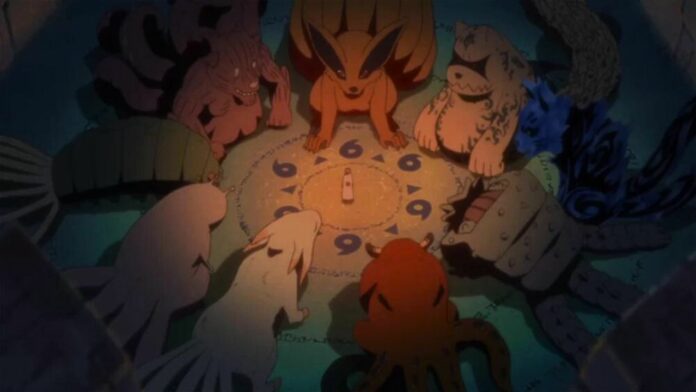In the world of Naruto, the Tailed Beasts are more than just powerful creatures; they play a crucial role in the series’ lore and character development.
Let’s delve into the significance of the Tailed Beasts in Naruto, exploring their impact on the storyline, the themes they embody, and their influence on the characters.
Introduction to the Tailed Beasts
The Tailed Beasts, known as Bijuu in the Naruto universe, are nine gigantic creatures, each with a different number of tails, ranging from one to nine.
They are made entirely of chakra and are known for their immense power.
Each beast has its unique abilities and personality, and they play a pivotal role in the series’ mythos and the ninja world’s history.
List of the Ten Tailed Beasts
Shukaku (One-Tail) – A sand spirit resembling a tanuki (raccoon dog). Shukaku is known for its immense power over sand and wind, often portrayed as temperamental and cunning.
Matatabi (Two-Tails) – Resembling a large, fiery cat, Matatabi is a nekomata (mythical two-tailed cat). It has immense agility and can control and manipulate fire.
Isobu (Three-Tails) – A giant turtle mixed with aspects of a crab and shrimp. Isobu can create coral and manipulate water, and is known for its sealed, reclusive nature.
Son Goku (Four-Tails) – Resembling the Monkey King from folklore, Son Goku is a gorilla-like creature with great strength and the ability to manipulate lava and fire.
Kokuo (Five-Tails) – Appears as a white horse with dolphin-like characteristics. Kokuo can manipulate steam and has a calm, noble demeanor.
Saiken (Six-Tails) – Resembling a giant slug, Saiken has abilities related to water and acid. It is depicted as gentle and less aggressive than some of the other Tailed Beasts.
Chomei (Seven-Tails) – Takes the form of a kabutomushi (rhinoceros beetle) with insectoid and armored characteristics.
Chomei can fly and has a secretive, elusive personality.
Gyuki (Eight-Tails) – A combination of an ox and an octopus, Gyuki has formidable physical strength and can manipulate ink.
It is known for its more composed and wise nature.
Kurama (Nine-Tails) – The most famous Tailed Beast, Kurama is a fox with immense chakra and power, capable of devastating attacks.
Initially portrayed as malevolent, its character develops significantly throughout the series.
Ten-Tails – The original divine tree from which all other Tailed Beasts were born.
It’s a combination of all the Tailed Beasts and is the most powerful entity, often depicted as a monstrous figure with no distinct personality.
Symbolism and Mythology of the Tailed Beasts
The Tailed Beasts are deeply rooted in the series’ mythology and symbolize various aspects of the ninja world.
They represent the natural forces of the world and are often viewed as both protectors and destroyers.
Their existence ties closely to the themes of war, peace, and the cyclical nature of hatred within the world of Naruto.
The Jinchuriki: Humans Linked to Tailed Beasts
A significant aspect of the Tailed Beasts’ role in Naruto is their connection to human hosts, known as Jinchuriki.
These individuals have a Tailed Beast sealed within them, granting them extraordinary powers but often at a great personal cost.
The series explores the complex relationships between the Tailed Beasts and their Jinchuriki, highlighting themes of loneliness, acceptance, and the struggle for control.
Impact on Character Development
The presence of the Tailed Beasts significantly impacts the development of various characters, especially Naruto Uzumaki, the series’ protagonist.
Naruto’s journey of coming to terms with the Nine-Tails Fox inside him is a central element of his character arc.
His relationship with the Nine-Tails evolves throughout the series, reflecting Naruto’s growth and his changing views on power, friendship, and coexistence.
Tailed Beasts and the Ninja World’s Power Dynamics
The Tailed Beasts are integral to the power dynamics of the ninja world.
Various villages and factions seek to control these creatures for their immense power, leading to conflicts and wars.
The series portrays the political and ethical implications of wielding such power, delving into the consequences of using living beings as weapons.
The Theme of Unity and Understanding
One of the overarching themes in Naruto involving the Tailed Beasts is the pursuit of unity and understanding.
The series ultimately advocates for a world where humans and Tailed Beasts can coexist in harmony, moving away from a history of fear, hatred, and exploitation.
This theme is pivotal to the series’ message of breaking the cycle of hatred and working towards a more peaceful world.
In Naruto, the Tailed Beasts are more than just powerful entities; they are central to the series’ narrative and thematic exploration.
They symbolize various aspects of the world, from natural forces to the consequences of wielding immense power.
Through the stories of the Tailed Beasts and their Jinchuriki, Naruto delves into deep themes such as loneliness, power, coexistence, and the importance of understanding and empathy.
The Tailed Beasts significantly contribute to the richness and depth of the Naruto universe, making them an integral part of the series’ appeal.
Also Read: Character focus: Hinata Hyuga’s development

